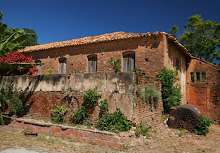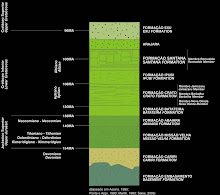
Of all the richest fossil-bearing deposits ever known, Brazil's Santana Formation is ranked among the world's greatest. Santana fossils are known for not only their extreme diversity but more importantly, for the nature of their breath-taking preservation - considered by scientists to include the finest examples of fossils in existence.
The formation provides an amazing window into the paleobiota of a prehistoric world from the Lower Cretaceous, 110 million years ago. The Santana fossils of Brazil were first recorded in the year 1828 by two natural historians, Dr. J. B. von Spix and Dr. C. F. P. von Martius, commissioned by the king of Bavaria.
To this day, they are still being studied with many new discoveries coming to light. Our recent purchase of a 70+ year old private European collection of vertebrate Santana fossils has provided us with numerous spectacular quality specimens that go well beyond the quality and completeness of anything we have seen in either private hands or in museum collections.
While these specimens were originally collected in the 1930's before the ban enacted in 1942, they had remained in their raw state "as collected" up until only recently, whereby they were prepared utilizing the most modern laboratory techniques and equipment hence their remarkable state of display.
In comparison, the definitive illustrated work on these fossils, written by curator John G. Maisey titled "Santana Fossils", is illustrated with numerous prized specimens owned by the American Museum of Natural History (AMNH) in New York. The specimens we acquired and offer here, far exceed the quality of the finest specimens shown from the American Museum in this publication.
The method of preparation for the concretionary specimens we obtained utilized procedures that produce whole, fully exposed fossils without splitting the concretions open and destroying the specimen as most others have done. The collection we acquired encompasses a variety of extremely rare vertebrates including fish and reptiles such as pterosaurs, in stunning degrees of preservation that rivals or even surpasses the finest acid-prepared examples housed in the American Museum of Natural History.
With these specimens we are offering, there is no comparison to the "butchered" concretionary Brazilian fossils that are crudely split with chisels to reveal the fossil inside. Our collection has not been subjected to such treatment and are whole, fully three dimensionally examples prepared with the most advanced paleontological lab techniques and equipment. This fish fossil is an ULTRA RARE example of the species Araripichthys. AMNH curator John Maisey writes about Araripichthys,
"This spectacular deep-bodied fish is a rare component of the Santana Formation fossil fish assemblages. It was first described only in 1985 on the basis of five reasonably complete specimens". In his publication, he informs the reader that the standard length of the specimens known are 28 cm or 11 inches in length. In comparing the museum's examples of Araripichthys to this example, the size is substantially greater on this one at 14.75 inches.
The quality of this example can be compared to the American Museum's complete specimen on page 213, which lacks many features visible in this complete specimen offered for sale. The full, lifelike relief throughout of this amazing specimen must be seen in person to appreciate. Furthermore, it is 100% COMPLETE AND ORIGINAL with NO RESTORATION and a single fracture across the posterior region just ahead of the tail but this required no restoration to repair. Fractures to these nodules are common and occur in the environment over time so they are typical and expected.
Considering the rarity of this investment-grade fish fossil and the fact that it meets or exceeds the finest museum specimen featured in this #1 publication on Santana Formation fossils, this stunning Araripichthys makes for a highly important addition to any collection. It is a magnificent specimen to display the finest possible, rare life-like 3D state of breath-taking preservation. Dinosaurs ruled the earth and pterosaurs ruled the skies when this fish swam amidst the depths of a Cretaceous sea.
The formation provides an amazing window into the paleobiota of a prehistoric world from the Lower Cretaceous, 110 million years ago. The Santana fossils of Brazil were first recorded in the year 1828 by two natural historians, Dr. J. B. von Spix and Dr. C. F. P. von Martius, commissioned by the king of Bavaria.
To this day, they are still being studied with many new discoveries coming to light. Our recent purchase of a 70+ year old private European collection of vertebrate Santana fossils has provided us with numerous spectacular quality specimens that go well beyond the quality and completeness of anything we have seen in either private hands or in museum collections.
While these specimens were originally collected in the 1930's before the ban enacted in 1942, they had remained in their raw state "as collected" up until only recently, whereby they were prepared utilizing the most modern laboratory techniques and equipment hence their remarkable state of display.
In comparison, the definitive illustrated work on these fossils, written by curator John G. Maisey titled "Santana Fossils", is illustrated with numerous prized specimens owned by the American Museum of Natural History (AMNH) in New York. The specimens we acquired and offer here, far exceed the quality of the finest specimens shown from the American Museum in this publication.
The method of preparation for the concretionary specimens we obtained utilized procedures that produce whole, fully exposed fossils without splitting the concretions open and destroying the specimen as most others have done. The collection we acquired encompasses a variety of extremely rare vertebrates including fish and reptiles such as pterosaurs, in stunning degrees of preservation that rivals or even surpasses the finest acid-prepared examples housed in the American Museum of Natural History.
With these specimens we are offering, there is no comparison to the "butchered" concretionary Brazilian fossils that are crudely split with chisels to reveal the fossil inside. Our collection has not been subjected to such treatment and are whole, fully three dimensionally examples prepared with the most advanced paleontological lab techniques and equipment. This fish fossil is an ULTRA RARE example of the species Araripichthys. AMNH curator John Maisey writes about Araripichthys,
"This spectacular deep-bodied fish is a rare component of the Santana Formation fossil fish assemblages. It was first described only in 1985 on the basis of five reasonably complete specimens". In his publication, he informs the reader that the standard length of the specimens known are 28 cm or 11 inches in length. In comparing the museum's examples of Araripichthys to this example, the size is substantially greater on this one at 14.75 inches.
The quality of this example can be compared to the American Museum's complete specimen on page 213, which lacks many features visible in this complete specimen offered for sale. The full, lifelike relief throughout of this amazing specimen must be seen in person to appreciate. Furthermore, it is 100% COMPLETE AND ORIGINAL with NO RESTORATION and a single fracture across the posterior region just ahead of the tail but this required no restoration to repair. Fractures to these nodules are common and occur in the environment over time so they are typical and expected.
Considering the rarity of this investment-grade fish fossil and the fact that it meets or exceeds the finest museum specimen featured in this #1 publication on Santana Formation fossils, this stunning Araripichthys makes for a highly important addition to any collection. It is a magnificent specimen to display the finest possible, rare life-like 3D state of breath-taking preservation. Dinosaurs ruled the earth and pterosaurs ruled the skies when this fish swam amidst the depths of a Cretaceous sea.
In John Maisey's book titled "Santana Fossils", he cites the prevalence of fake, composite and enhanced fossils from this formation that are on the market. The local artisans at the sites produce a wide variety of artificially created fossils - some horribly obvious yet some, extremely convincing out of carefully matched composite pieces. These composite examples are very convincing because they are made up of all real pieces but not necessarily of the same species! Often, missing parts are carved or sculpted from a mixture of plaster, rock dust and epoxy and then painted to disguise the work.
A number of these handcrafted "fossils" have in the past, and continue to, make it into the mainstream fossil market. Describing a variety of techniques and types of fakes, Maisey even shows photographs of some fakes for reference to illustrate the breadth, creativity and skill of some of these workers. He also addresses the prevalence of fake insect and other rare fossils within the text. With all Brazilian fossils, collectors should approach prospective purchases with caution for not only the legality of the specimen but also, for accurate disclosure by a qualified and experienced preparator of any artificial enhancement to the specimen. PALEO DIRECT guarantees every Santana Formation specimen we offer to be AUTHENTIC and "as described" with a written unlimited lifetime guarantee / certificate of its authenticity and data sheet.
Anúncio publicado no site http://www.paleodirect.com/, da Florida, Estados Unidos, que estima o valor de venda do fóssil do peixe Araripichthys, em US 19.500(Dezenove mil e quinhentos dólares).





Nenhum comentário:
Postar um comentário